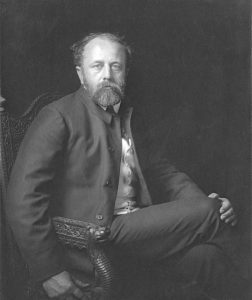
(Click here for a list of his works)
Stephens was born on in Toowoomba, Queensland, on 28 August 1865, to a Welsh father and a Scottish mother, and was educated in Toowoomba and Sydney. His father was part-owner of the Darling Downs Gazette, and Alfred worked in that establishment when a boy. He served as an apprentice with William Henry Groom, proprietor of the Chronicle in Toowoomba, and then with the printer A. W. Beard in Sydney.
He became editor of the Gympie Miner in 1888, staying there until 1890, was sub-editor for the Boomerang in Brisbane, and then was editor of the Argus in Cairns from 1891 to 1892. Stephens went on a travel spree in 1893, voyaging through America and Europe; he sent essays about his trips back to Australia, where they were published in newspapers. His articles from his journeying were later put together in a book as A Queenslander’s Travel-Notes.
After his arrival back in Australia, in January 1894 he started work for The Bulletin, which was to be the real beginning of the literary career which was to make him famous in Australian literary circles.
He married Constance Ivingsbelle Smith in 1894, with whom he was to have two sons and four daughters.
In The Bulletin, Stephens created a column dedicated to literature, which became widely known as the “Red Page”, as it was printed on the inside cover of the magazine, the covers of which were printed on red paper. As part of his work for the The Bulletin, he created a literary magazine called The Bookfellow, but unfortunately it was short-lived and came to an end after just five issues.
In October of 1906, A. G. Stephens ended his association with The Bulletin. Norman Lindsay wrote of the incident, that “When he later took a year off for travel in Europe, and returned to ask for a rise in his screw [wages], Macleod refused it, so in a tiff A.G. resigned from the paper. He was a fool to leave it and Macleod was a bigger fool to let him go.”
Stephens started a new literary magazine, entitled The Bookfellow, the name being the same as that of his previous attempt. However, this venture also failed, lasting only from 3 January 1907 to 25 April 1907.
Stephens then worked for the Evening Post in Wellington, New Zealand, until 1909. After coming back to Australia, he tried once more to make a success of a literary magazine, again calling it The Bookfellow, and this journal was published from December 1911 to February 1916. Following the end of World War One, he picked up the reins once more and The Bookfellow was resurrected yet again, for a span of several years (albeit with some gaps in production), from November 1919 to March 1925.
Even after the final closure of his magazine, A. G. Stephens remained a part of the literary industry, publishing various books by authors and poets, as well as writing his own articles, poetry, and short stories.
He died in St Luke’s Hospital, Darlinghurst, New South Wales, on 15 April 1933.
Books and other works by A. G. Stephens:
Works of A. G. Stephens
References:
Stuart Lee, “Stephens, Alfred George (1865–1933)”, Australian Dictionary of Biography, National Centre of Biography, Australian National University (accessed 5 February 2014)
“Stephens, Alfred George (1865–1933)” (Australian Dictionary of Biography, Angus and Robertson, 1949), Project Gutenberg Australia (accessed 12 February 2014)
Norman Lindsay, Bohemians at The Bulletin, London; Sydney: Angus & Robertson, 1980, p. 38 [originally published as Bohemians of The Bulletin, 1965]
Further information:
“Alfred Stephens”, Wikipedia
Leave a Reply